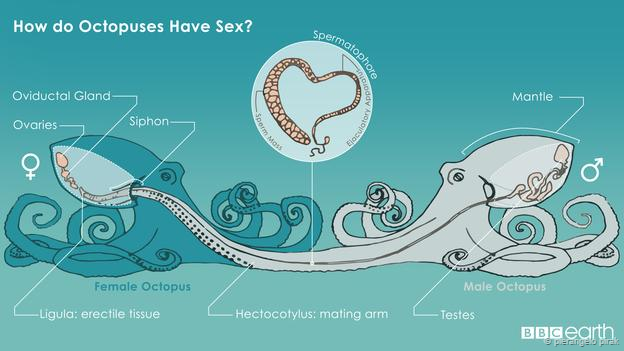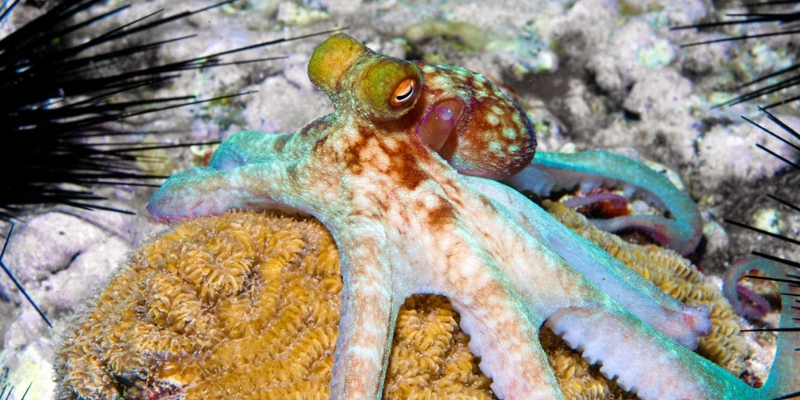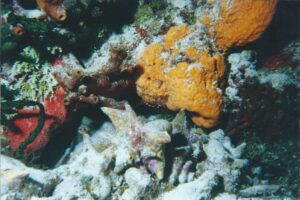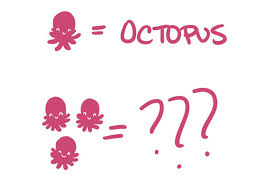Reproduction and Life Cycle
In our previous newsletter, two weeks ago, we had part one of our two part series on the octopus and we asked the question; Which side of the debate are you on…octopuses or octopi? Well in this weeks article along with more fun facts about the octopus, I promise we’ll settle this debate. If you missed the previous article CLICK HERE and if you missed our last newsletter CLICK HERE and subscribe today.
All octopus species are semelparous, meaning that they only have one reproductive cycle their entire life. How sad! However during this single cycle the male and female may mate with several other octopus over a week period.
The Common Octopus mates during the winter. During mating, the male octopus inserts its hectocotylus directly into the female’s mantle and deposits packets of sperm. Egg fertilization takes place internally, before the female lays the eggs. The male will die shortly after mating.
The female will lay the eggs, which are approximately the size of a grain of rice, under rocks or in holes. She will lay 100,000 – 500,000 eggs. The female does not leave after laying the eggs and spends her time cleaning the eggs and protecting them from predators. She will not feed during this time. In four to eight weeks the eggs hatch.
The newly born octopus larvae closely resemble their parents and will live amongst and feed on the plankton for 45 to 60 days. Following that time, the surviving juvenile octopus will move to the ocean floor. It is believed that less than 1% of the hatchlings survive to adulthood. The juveniles that survive will typically live up to 1.5 years. The female octopus dies shortly after the eggs hatch.
Food
Most hunting is done between dusk and dawn. This is when octopus food sources are more active, predators are less abundant and the octopus can hide their movements in the darkness. One of the primary food sources is the spiny lobster. They are also known to eat crabs, shrimp, small fish and small mollusks. On occasion, they may eat another octopus, which is likely the result of a territorial dispute.
The octopus uses a mix of hunting styles, depending on the target prey. It can walk along the reef and seagrass bed, which is most effective when searching for bivalve mollusks and gastropods, which are not able to rapidly flee. They will grab their prey and guide it to their mouth.
When seeking crustaceans and small fish, the octopus becomes an ambush predator. It can often be seen pouncing on its prey, spreading its webbed arms to form a net like canopy over the prey. It reaches under the canopy and uses its arms to move the prey to its mouth.
Once the octopus has captured and bites its prey the octopus releases venom, which paralyzes the prey and allows the octopus to feed without a huge struggle. The octopus will then use its parrot like beak to break open the shell of its dinner. Using its toothed tongue like organ called a radula, the octopus will rasp its dinner out of the shell.
Have you ever found a shell or crab remains that appear to have a hole drilled through the shell? That is possibly the result of another feeding method of the octopus. Using another tooth-covered organ called a salivary papilla and a secretion that dissolves calcium carbonate, the octopus “drills” a small hole through the shell.
The octopus then releases a neurotoxin and enzymes into the shell. This serves to neutralize and soften the food, which is then consumed by the octopus.
The Common Octopus prefers to bring its food back to den to consume it. Often it will discard the remains outside its den. Looking for these piles of shells can help you spot an octopus, in their den, on daytime dives.
Predators and Defense
Natural predators of the octopus include dolphins, rays, sharks, eels, other large fish, aquatic mammals and of course humans. If you enjoy eating octopus or are interested in trying it, it is actually highly nutritious. A 3-ounce serving has 139 calories, 2 grams of fat, 25 grams of protein, 45% of your daily iron and 510% of your daily vitamin B12.
To protect itself, the octopus stays hidden in or flees into small openings in the reef to hide from predators. The other method is to hide in plain site by using its mastery of camouflage. The octopus is able to instantly change the color and texture of their skin to match their surroundings. This is the result of thousands of pigment sacs called chromatophores.
The chromatophores contain brown, black, red, orange and yellow pigments. By relaxing and contracting muscles around the chromatophores, the octopus is able to create different colors and shadings. In addition, the octopus has specialized cells called iridophores. The iridophores have reflective properties that help to mirror the environment. One more weapon in the octopus’ camouflage arsenal are raised points in the skin called papillae. The papillae are what gives the octopus the ability to change the texture of their skin. The octopus is said to be able to make a full body transformation in three-tenths of a second.
In addition to camouflage, it is also believed that an octopus uses it color changing ability to communicate with another octopus or to warn predators. The areas around the eyes, suckers, arms and web may darken to make the octopus appear more threatening. The color is also believed to communicate the octopus’ mood, turning white to show fear and turning red to show anger. Check out this short video to see how the octopus is continually changing his color and skin texture while on the move.
When it comes to fight or flight, the octopus will almost always choose flight. The octopus can jet away at speeds of up to 25 m.p.h. to escape. This is accomplished by sucking water into the mantle, contracting the muscles quickly and rapidly forcing the water out through the siphon. By moving the siphon, the octopus can quickly change direction. An octopus will use this method sparingly and generally as a last resort. According to Smithsonian Magazine, the heart that supplies blood to the organs stops beating when they swim, which exhausts the octopus quickly.
In conjunction with the octopus’ jet propulsion, it has the ability to release ink through the siphon, with a burst of water. The octopus can release several small blobs of ink, which act as a decoy or it can release a large cloud of ink to conceal its escape. The ink is in large part made of melanin, which is the same substance that gives color to human skin, hair and eyes. The ink also contains a chemical called tyrosinase. This chemical irritates the predator’s eyes and blocks their sense of smell making it difficult to track the fleeing octopus. This gives the octopus the opportunity the camouflage itself on the reef or to find a hole to retreat into.
If the octopus does fall victim to a predator, it has the ability to detatch an arm. Due to the neurons in the arm, it will continue move, without communication from the brain. This further distracts and occupies the attention of the predator while the octopus escapes. The octopus will then regenerate the lost arm, in a relatively short amount of time.
Octopuses or Octopi?
So, which side are you on…….octopuses or octopi? If you said octopi, you would be wrong…………and right. How can that be? The grammatically correct plural of octopus is octopuses, although according to the Merriam-Webster Dictionary, either octopuses or octopi are acceptable plurals. Merriam-Webster also points out that there are actually three terms used: octopuses, octopi and octopodes. The Oxford English Dictionary states that octopi is based on the pluralization of Latin words.
However, octopus is derived from the Greek word októpous and the proper pluralization of the Greek word would be octopodes. This form may be used, although rarely, and would likely cause more confusion. Octopi was used during the 19th century. However, grammar experts point out that the classic English formulation of adding an “es” is the appropriate plural and this has been the standard plural in both American and British English since the early 1900’s.
Even though octopuses is grammatically correct, the bottom line is that you can use octopi and you will probably never get called on it. In the event that you do get called on it, there will likely not be a winner in the argument over which is correct. If you are looking to create confusion or really want to stir the pot………..go with octopodes.
Thanks to Ron Knafla for
putting together this article





